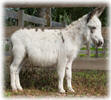Miniature Donkeys
Appearance, Characteristic, Size
ForSale:
Check Our Availability
 Check
out our For Sale Page.
Check
out our For Sale Page.
We have Jennies, Jacks and Yearlings Available.
HerdSires
Meet Flash!
Meet Our Newest Spotted Jack
 Flash
is one of our new spotted Jacks. Come Meet Flash! ....continue
Flash
is one of our new spotted Jacks. Come Meet Flash! ....continue
Training
How Do I Do That?
They're So Cute
 We believe Miniature Donkeys were bred to be, and should remain, athletic and capable animals. In our breeding program we select for donkeys with the big stride, grace, and balance that are desirable in a top performance animal.
...continue
We believe Miniature Donkeys were bred to be, and should remain, athletic and capable animals. In our breeding program we select for donkeys with the big stride, grace, and balance that are desirable in a top performance animal.
...continue
Miniature Donkeys
General Appearance
What Are You Looking For?
The Miniature Donkey should be attractive, sound, strong and sturdy. The animal should be well-balanced as the various parts blend together in a nicely coupled, compact picture. It should have an alert expression and "presence"; Jennets should look feminine and slightly more refined and jacks should be relatively stocky and masculine. A maximum height of 36" at the withers, measured at 3 years, is accepted by the Miniature Donkey Registry. Overall bone should be strong and in proportion to the size of the Donkey and muscle development.
Overall balance in conformation and adequate bone is necessary for work, such as carrying packs and pulling carts efficiently.
What are you looking for? Show, Breed Stock, Pet? ....continue
Origination and Characteristics
Miniature donkeys are native to the Mediterranean islands of Sicily and Sardinia. They are identified as either Sicilian or Sardinian donkeys according to their ancestry, although the two types do not differ. They have been extensively bred with each other and with animals of unidentified ancestry in the United States to produce a distinctively American breed of donkeys, which we call the Miniature Mediterranean Donkey. According to all information that can be acquired these donkeys are nearly extinct in the land of their origin and have been brought to their current state of being an excellent breed by breeders in the United States who have bred for years for size, disposition and conformation.
There are probably about 10,000 of these donkeys in the United States today but there is not an accurate account of them because they are not all registered. A registry was established in 1958 by Danby Farm in Nebraska and is now a part of the American Donkey and Mule Society in Denton, Texas. Approximately 15,000 of these donkeys have been registered since the inception of the registry but many more exist in unregistered herds. The breed is defined by size. The adult miniature donkey must not be more than 36 inches tall when mature, measured from the highest point of the withers to the ground.
Characteristics ....continue
Size of Donkey
Donkeys come in a variety of sizes from the Miniature Mediterranean (under 36 inches) to the elegant Mammoth Jackstock (14 hands and up ). The rare French Poitou donkey, characterized by it's huge head and ears, and very thick, shaggy, curled black coat, can stand 14 to 15 hand high. (There are estimated to be about 400 purebred Poitous left in the world today.)
The types of donkeys are labeled by their sizes;
36" and under, Miniature Mediterranean
36.01-48", Standard
48.01" to 54" (jennets) or 56"; (jacks), Large Standard
54/56" and over, Mammoth Stock
Colors of Donkeys
Donkeys come in a variety of colors. The most prevalent color for Miniature Donkeys is gray-dun which consists of a gray colored body, light colored nose - or dark colored nose -, light colored belly and inside legs, with a dark color dorsal stripe down the back and over the shoulders. The dorsal stripe is known as the donkeys cross. There are variations of this gray-dun from dark to light. Donkeys can range in color from black to white and everything in between. True blacks are rare with black/browns (not quite black) being more common. There are chestnut/sorrels which are various shades of reddish brown. There are also white donkeys and "spotted" donkeys. Some people refer to spotted as "pinto", "piebald" or "skewbald" and this really boils down to semantics. Spotted donkeys are generally gray, black or brown and white. There are also various colors of roans. Roan coloring is black, brown, gray hairs intermingled with white hairs. Donkeys do not breed true to color. Since gray-dun is by far the predominant gene, you can breed black to black and get gray-dun, spotted to spotted and get gray-dun, etc. Colors other than the typical gray-dun makes the donkey more exotic looking therefore increases their price.

